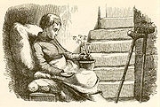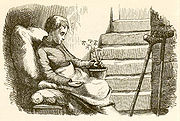
The Angel
Encyclopedia
"The Angel" is a literary fairy tale
by Hans Christian Andersen
about an angel and a dead child gathering flowers to carry to Heaven. The tale was first published with three others in New Fairy Tales
by C.A. Reitzel in November 1843
. The four tales were received by the Danish critics with great acclaim. A print depicting the angel and child became very popular.
 "The Angel" was first published in Copenhagen on 11 November 1843 by C. A. Reitzel in the first volume of the first collection of New Fairy Tales. For the first time, the phrase "told for children" was not part of the title—an omission Andersen scholar and biographer Jackie Wullschlager believes exhibited a new confidence on Andersen's part: "These [tales] were the most mature and perfectly constructed tales he had written, and though some of them at once became, and have remained favorites of children, Andersen here melds together the childlike and the profound with exceptional artistry." The first edition of 850 was sold out by December 18, and Reitzel planned publication of another 850.
"The Angel" was first published in Copenhagen on 11 November 1843 by C. A. Reitzel in the first volume of the first collection of New Fairy Tales. For the first time, the phrase "told for children" was not part of the title—an omission Andersen scholar and biographer Jackie Wullschlager believes exhibited a new confidence on Andersen's part: "These [tales] were the most mature and perfectly constructed tales he had written, and though some of them at once became, and have remained favorites of children, Andersen here melds together the childlike and the profound with exceptional artistry." The first edition of 850 was sold out by December 18, and Reitzel planned publication of another 850.
"The Angel" was the first tale in the volume that included "The Nightingale", "The Sweethearts; or, The Top and the Ball
", and "The Ugly Duckling
". The tale was republished 18 December 1849 in Fairy Tales and again on 15 December 1862 in Fairy Tales and Stories.
Wullschlager describes "The Angel" as a "sentimental genre picture [...] that suited the taste of the times." A print made from an illustration of the tale by the German artist Wilhelm von Kaulbach
was widely popular and sold briskly. Andersen once found the print in Portugal, a country in which he relatively unknown.
Fairy tale
A fairy tale is a type of short story that typically features such folkloric characters, such as fairies, goblins, elves, trolls, dwarves, giants or gnomes, and usually magic or enchantments. However, only a small number of the stories refer to fairies...
by Hans Christian Andersen
Hans Christian Andersen
Hans Christian Andersen was a Danish author, fairy tale writer, and poet noted for his children's stories. These include "The Steadfast Tin Soldier," "The Snow Queen," "The Little Mermaid," "Thumbelina," "The Little Match Girl," and "The Ugly Duckling."...
about an angel and a dead child gathering flowers to carry to Heaven. The tale was first published with three others in New Fairy Tales
New Fairy Tales (1844)
New Fairy Tales is a collection of four fairy tales written by Hans Christian Andersen and published by C. A. Reitzel in Copenhagen, Denmark on 10 November 1843. As was customary at the time however, the title page is dated 1844. The tales are completely Andersen's invention, owe no debt to folk...
by C.A. Reitzel in November 1843
1843 in literature
The year 1843 in literature involved some significant new books.-New books:*William Harrison Ainsworth - Windsor Castle*Edward George Bulwer-Lytton - The Last of the Barons*James Fenimore Cooper - Le Mouchoir; an Autobiographical Romance...
. The four tales were received by the Danish critics with great acclaim. A print depicting the angel and child became very popular.
Plot
When the tale opens, a child has died, and an angel is escorting him to Heaven. They wander over the earth for a while, visiting the child's favourite places. Along the way they gather flowers to transplant into the gardens of Heaven. The angel takes the child to a poverty-stricken area where a dead field lily lies in a trash heap. The angel salvages the flower explaining that it had cheered a crippled boy before he died. The angel then reveals he was the boy.Themes
Jens Andersen, author of Hans Christian Andersen: A New Life (2005) describes Death as "one of Andersen's most beloved ghosts" and notes that Death in "The Angel" is a "pleasant and helpful traveling companion [...] There are few figures in his works to whom he returns more often or examines from so many different childish angles." The poet had an unshakable faith that a whole new existence awaited him once his spirit left his earthly frame at the appropriate time. When Andersen was assailed with doubts regarding the soul's immortality, he reverted to his child faith and could not bring himself to suggest that the human being is simply dispersed as gases and other substances to fertilize the earth at death as the scientific Niels Bryde does in Andersen's 1857 novel, "To Be or Not To Be". Andersen regarded Death as a release for those suffering and a new chance for those who have failed. Death was an optimistic and promising beginning for Andersen.Background
The tale is completely Andersen's invention, and may have been motivated by the death of the eldest daughter of his friends, Edvard and Jette Collins. The theme of a child transformed into an angel had possessed Andersen since the completion of his poem "The Dying Child".Publication history

"The Angel" was the first tale in the volume that included "The Nightingale", "The Sweethearts; or, The Top and the Ball
The Sweethearts; or, The Top and the Ball
"The Sweethearts; or, The Top and the Ball" is a literary fairy tale by Hans Christian Andersen about the unrequited love a mahogany top suffers for a leather ball. It is likely the tale's inspiration lies in Andersen’s youthful relationship with Riborg Voight, a woman who declined his marriage...
", and "The Ugly Duckling
The Ugly Duckling
"The Ugly Duckling" is a literary fairy tale by Danish poet and author Hans Christian Andersen . The story tells of a homely little bird born in a barnyard who suffers abuse from his neighbors until, much to his delight , he matures into a beautiful swan, the most beautiful bird of all...
". The tale was republished 18 December 1849 in Fairy Tales and again on 15 December 1862 in Fairy Tales and Stories.
Wullschlager describes "The Angel" as a "sentimental genre picture [...] that suited the taste of the times." A print made from an illustration of the tale by the German artist Wilhelm von Kaulbach
Wilhelm von Kaulbach
Wilhelm von Kaulbach was a German painter, noted mainly as a muralist, but also as a book illustrator. His murals decorate buildings in Munich.-Education:...
was widely popular and sold briskly. Andersen once found the print in Portugal, a country in which he relatively unknown.
Critical response
New Fairy Tales was a break-through for Andersen who, until its publication, had generally received vigorous condemnation from the Danish critics for his venture into the fairy tale genre. Reviews for the collection however were ecstatic. Ny Portefeuille wrote, "There is in these tales so much beauty and goodness, so much humour and seriousness, so much poetry and depth, that even the most disparate readers will by necessity find something of interest to them." Andersen wrote his confidante Henriette Wulff, "These tales have been received with unanimous applause. None of my other books have had such a success here at home, every paper commends them, everyone reads them...I am appreciated as the best fairy-tale teller."External links
- Engelen. Original Danish text
- "The Angel". English translation by Jean HersholtJean HersholtJean Pierre Hersholt was a Danish-born actor who lived in the United States, where he was a leading film and radio talent, best known for his 17 years starring on radio in Dr. Christian and for playing Shirley Temple's grandfather in Heidi...

